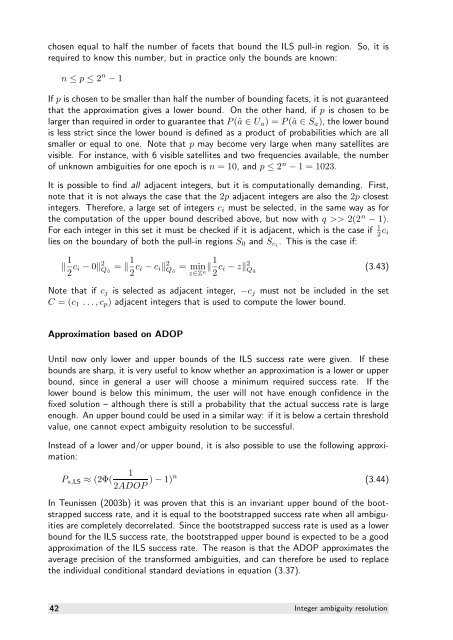The GNSS integer ambiguities: estimation and validation
The GNSS integer ambiguities: estimation and validation
The GNSS integer ambiguities: estimation and validation
Create successful ePaper yourself
Turn your PDF publications into a flip-book with our unique Google optimized e-Paper software.
chosen equal to half the number of facets that bound the ILS pull-in region. So, it is<br />
required to know this number, but in practice only the bounds are known:<br />
n ≤ p ≤ 2 n − 1<br />
If p is chosen to be smaller than half the number of bounding facets, it is not guaranteed<br />
that the approximation gives a lower bound. On the other h<strong>and</strong>, if p is chosen to be<br />
larger than required in order to guarantee that P (â ∈ Ua) = P (â ∈ Sa), the lower bound<br />
is less strict since the lower bound is defined as a product of probabilities which are all<br />
smaller or equal to one. Note that p may become very large when many satellites are<br />
visible. For instance, with 6 visible satellites <strong>and</strong> two frequencies available, the number<br />
of unknown <strong>ambiguities</strong> for one epoch is n = 10, <strong>and</strong> p ≤ 2 n − 1 = 1023.<br />
It is possible to find all adjacent <strong>integer</strong>s, but it is computationally dem<strong>and</strong>ing. First,<br />
note that it is not always the case that the 2p adjacent <strong>integer</strong>s are also the 2p closest<br />
<strong>integer</strong>s. <strong>The</strong>refore, a large set of <strong>integer</strong>s ci must be selected, in the same way as for<br />
the computation of the upper bound described above, but now with q >> 2(2n − 1).<br />
For each <strong>integer</strong> in this set it must be checked if it is adjacent, which is the case if 1<br />
2ci lies on the boundary of both the pull-in regions S0 <strong>and</strong> Sci . This is the case if:<br />
1<br />
2 ci − 0 2 Qâ = 1<br />
2 ci − ci 2 Qâ = min<br />
z∈Zn1 2 ci − z 2 Qâ<br />
(3.43)<br />
Note that if cj is selected as adjacent <strong>integer</strong>, −cj must not be included in the set<br />
C = (c1 . . . , cp) adjacent <strong>integer</strong>s that is used to compute the lower bound.<br />
Approximation based on ADOP<br />
Until now only lower <strong>and</strong> upper bounds of the ILS success rate were given. If these<br />
bounds are sharp, it is very useful to know whether an approximation is a lower or upper<br />
bound, since in general a user will choose a minimum required success rate. If the<br />
lower bound is below this minimum, the user will not have enough confidence in the<br />
fixed solution – although there is still a probability that the actual success rate is large<br />
enough. An upper bound could be used in a similar way: if it is below a certain threshold<br />
value, one cannot expect ambiguity resolution to be successful.<br />
Instead of a lower <strong>and</strong>/or upper bound, it is also possible to use the following approximation:<br />
1<br />
Ps,LS ≈ (2Φ( ) − 1)n<br />
2ADOP<br />
(3.44)<br />
In Teunissen (2003b) it was proven that this is an invariant upper bound of the bootstrapped<br />
success rate, <strong>and</strong> it is equal to the bootstrapped success rate when all <strong>ambiguities</strong><br />
are completely decorrelated. Since the bootstrapped success rate is used as a lower<br />
bound for the ILS success rate, the bootstrapped upper bound is expected to be a good<br />
approximation of the ILS success rate. <strong>The</strong> reason is that the ADOP approximates the<br />
average precision of the transformed <strong>ambiguities</strong>, <strong>and</strong> can therefore be used to replace<br />
the individual conditional st<strong>and</strong>ard deviations in equation (3.37).<br />
42 Integer ambiguity resolution
















